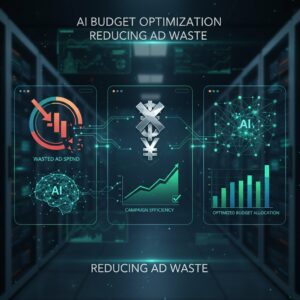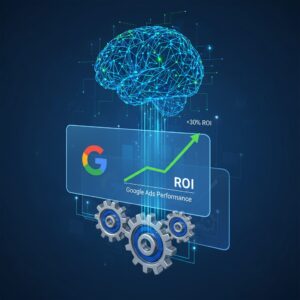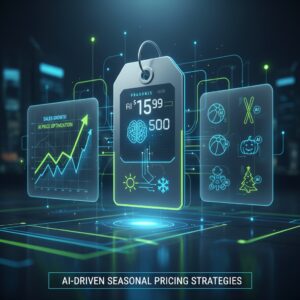
I’ve watched countless small businesses burn through their advertising budgets without understanding where their money actually goes. Most owners tell me they spend on Facebook ads, Google ads, maybe some Instagram promotion. When I ask them about their return, they give vague answers about getting some leads or a few sales.
This pattern repeats itself across industries. You’re not alone if you feel like half your ad budget disappears into thin air. The old marketing wisdom says you waste 50% of your advertising dollars but never know which half. That statistic hasn’t changed much, but the tools to fix it have.
AI budget optimization changes everything about how you manage advertising spend. I’m not talking about complicated enterprise software that requires a data science degree. I mean practical tools that learn from your campaigns and automatically shift money away from what doesn’t work toward what does.
Let me share what I’ve learned implementing these systems across dozens of small businesses.
Why Traditional Ad Management Fails Small Businesses
You probably manage your ads manually. You set a budget, choose your audience, write some copy, and hope for the best. Maybe you check in weekly to see how things perform. Perhaps you pause campaigns that seem expensive and boost ones that look promising.
This approach has fundamental problems.
First, you can’t monitor performance in real time. Ad performance changes by the hour. What works Monday morning might fail Tuesday afternoon. Your competitors adjust their bids. Audience behavior shifts. Platform algorithms update constantly. By the time you notice a problem, you’ve already wasted money.
Second, you can’t process enough data to make smart decisions. Each campaign generates thousands of data points across demographics, locations, devices, times of day, and creative variations. Your brain can’t analyze all these variables simultaneously to find patterns.
Third, you split your budget based on guesses rather than performance. You might allocate $500 to Facebook and $500 to Google because that feels balanced. But what if Facebook delivers three times the return? You’re leaving money on the table.
I worked with a retail client who spent $3,000 monthly across five platforms. When we analyzed their data, we discovered that 78% of their actual sales came from just one platform at specific times targeting specific demographics. They were essentially funding four expensive experiments while underfunding their one proven channel.
How AI Budget Optimization Actually Works
AI optimization tools connect to your advertising accounts and analyze performance continuously. They track every click, conversion, and cost in real time. Then they automatically move budget from underperforming campaigns to high performers.
The process runs 24/7 without your involvement. The system makes hundreds of micro adjustments that would be impossible manually. It identifies patterns you’d never notice. It responds to changes within minutes rather than days.
Here’s what happens in practice.
You set your total monthly budget and define what success means. Maybe you want leads under $20 each or sales with at least 3x return on ad spend. The AI takes over from there.
It starts by running your campaigns normally while collecting data. Within a few days, it begins making small adjustments. It notices that your ads perform better on mobile devices between 7pm and 9pm. It shifts more budget to those hours. It sees that certain keywords convert while others just burn money. It reduces spend on the waste.
The system tests variations constantly. It tries different audiences, ad formats, and bidding strategies. It keeps what works and kills what doesn’t. All automatically.
A restaurant client implemented AI optimization on a $2,000 monthly budget. The first month, the system identified that their lunch promotion ads worked great on weekdays but failed on weekends. Their dinner ads had the opposite pattern. It automatically shifted budget to match these patterns. Their cost per reservation dropped 34% without changing the creative or total spend.
Implementing AI Optimization In Your Business
You don’t need a big budget or technical expertise to start. Several platforms now offer AI optimization for small businesses at reasonable prices. Many charge based on your ad spend, typically 5% to 15% of your monthly budget.
Start by connecting your advertising accounts to the AI platform. This usually takes 15 minutes and doesn’t require any coding. You just authorize access through standard OAuth connections like you’d use to connect any business tool.
Set your performance goals clearly. Be specific about what you want. Don’t just say you want more leads. Define that you want leads at a specific cost or with specific characteristics. The clearer your goals, the better the AI can optimize toward them.
Let the system run for at least two weeks before judging results. AI optimization needs data to learn. The first few days might not show dramatic changes. The system is gathering information and testing hypotheses. Real improvements typically appear after the first full week.
Monitor the dashboard but resist the urge to interfere. Check your results weekly rather than daily. The AI makes many small adjustments that might look random in isolation but make sense as part of a larger strategy. Give it room to work.
One mistake I see often is setting the optimization window too short. Business owners want results today. They check performance daily and panic if one day looks weak. AI optimization works on patterns across time. Judge it on weekly or monthly performance, not daily fluctuations.
I had a service business client who nearly cancelled their AI optimization after three days because their cost per lead went up slightly. I convinced them to wait another week. By day 10, their cost per lead had dropped 40% below their previous average. The AI had been testing to find better audiences. The testing cost a bit extra initially but led to much better results.
You’ll also want to feed the system information it can’t get from advertising platforms alone. Tell it which leads actually became customers. Share revenue data so it can optimize for profit rather than just conversions. The more context you provide, the smarter it gets.
Set up proper conversion tracking before you start. The AI can only optimize what it can measure. If you’re not tracking phone calls, form submissions, purchases, or whatever matters for your business, fix that first. Most AI platforms include guides for setting up tracking correctly.
Your role shifts from campaign manager to strategy director. You decide which products to promote, what offers to make, and how to position your business. The AI handles the tactical execution of getting your message in front of the right people at the right price.
This freed up about 10 hours per week for one of my clients who had been managing campaigns manually. She redirected that time to improving her actual product and customer service. Her business grew faster because she focused on what only she could do rather than tasks a system could handle better.
Remember that AI optimization works with your existing ads. You don’t need to redesign everything. It takes what you’ve created and finds the best ways to deploy it. Over time, it will show you which messages and creative assets perform best, which helps you create better ads going forward.
The cost savings typically exceed the platform fees within the first month. My clients usually see 20% to 50% better performance on the same budget. Some reinvest the savings into additional advertising. Others pocket the difference as improved profit margins. Both approaches work.
You maintain full control and can adjust parameters anytime. If you want to test a new product or try a different market, you just tell the system. It adapts to your business goals rather than forcing you into a rigid structure.
AI budget optimization isn’t future technology. It’s available now at prices small businesses can afford. The question isn’t whether you should use it. The question is how much money you’re willing to waste before you start.
Please check our Business Tips https://thoughts.business/category/business-tips/
Please check our partner site – Why Invest? https://whyinvest.info/





